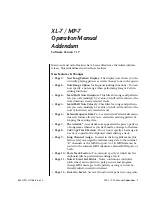
Inverse Assembler Problems
This section lists problems that you might encounter while using the
inverse assembler.
When you obtain incorrect inverse assembly results, it may be unclear
whether the problem is in the preprocessor or in your target system. If
you follow the suggestions in this section to ensure that you are using
the preprocessor and inverse assembler correctly, you can proceed
with confidence in debugging your target system.
No inverse assembly or incorrect inverse assembly
This problem may be due to incorrect synchronization, modified
configuration, incorrect connections, or a hardware problem in the target
system. A locked status line can cause incorrect or incomplete inverse
assembly.
Verify that the inverse assembler has been synchronized by placing an
opcode at the top of the display (not at the cursor position) and pressing
the Invasm key.
The inverse assembler works from the first line of the trace
display.
If you
jump to the middle of a trace and select Invasm, prior trace states may not be
disassembled correctly. If you move to several random places in the trace list
and synchronize the disassembly each time, the trace disassembly is only
guaranteed to be correct for the portion of the trace list disassembled. See
"To synchronize the inverse assembler" in Chapter 2 for more information.
Ensure that each logic analyzer pod is connected to the correct
connector.
There is not always a one-to-one correspondence between analyzer pod
numbers and connector numbers. Target systems must supply address
(ADDR), data (DATA), and status (STAT) information to the analyzer in a
predefined order. The cable connections for each connector are often
altered to support that need. Thus, one target system might require that you
connect cable 2 to analyzer pod 2, while another will require you to connect
cable 5 to analyzer pod 2. See Chapter 1 for connection information.
A–7
Summary of Contents for E2470A
Page 8: ...1 Setting Up the Preprocessor Interface ...
Page 22: ...2 Analyzing the Motorola MC68HC16Y1 ...
Page 34: ...3 Preprocessor Interface Hardware Reference ...
Page 38: ...Block Diagram Preprocessor Interface Hardware Reference Theory of Operation and Clocking 3 5 ...
Page 56: ...A If You Have a Problem ...










































